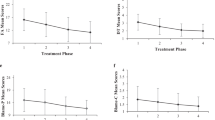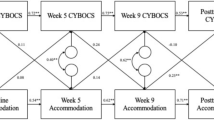Abstract
Family accommodation of symptoms is counter to the primary goals of cognitive-behavioral therapy for pediatric obsessive-compulsive disorder (OCD) and can pose an obstacle to positive treatment outcomes. Although increased attention has been given to family accommodation in pediatric OCD, relatively little is known about associated child and parent characteristics, and their mediating/moderating effects. This study examined a structural equation model of parent and child variables related to parent reports of family accommodation. Sixty-one children with OCD (ages 6–17 years, 39% female) and their parents were recruited from a university-based clinic. They were administered clinician- and parent-rated measures of child OCD symptom severity, OCD-specific impairment, internalizing problems, and externalizing problems as well as parent anxiety, depression, empathy, consideration of future consequences, and accommodation. Results generally supported the hypothesized model. Family accommodation mediated the relationship between OCD symptom severity and parent-rated functional impairment; child internalizing problems mediated the relationship between parent anxiety and family accommodation; and parent empathy and consideration of future consequences interacted to predict family accommodation. Child externalizing problems were significantly associated with family accommodation but neither of these two variables was associated with parent depression. Findings suggest that reductions in family accommodation might be maximized by routinely screening for comorbid psychopathology in children with OCD and their parents, and using prescriptive or modular approaches to intervention. Directions for future research are discussed.


Similar content being viewed by others
Notes
Non-normality was addressed using square-root transformations. Results did not vary substantively when analyses were conducted with transformed variables. Thus, results of analyses with non-transformed variables are reported.
References
Achenbach, T. M., & Rescorla, L. (2001). Manual for the ASEBA school-age forms and profiles. Burlington: Research Center for Children, Youth, & Families.
Aiken, L. S., & West, S. G. (1991). Multiple regression: Testing and interpreting interactions. Newbury Park: Sage.
American Psychiatric Association. (2000). Diagnostic and statistical manual of mental disorders (4th ed.). Washington, DC: Author.
Barrett, P., Healy-Farrell, L., & March, J. S. (2004). Cognitive-behavioral family treatment of childhood obsessive-compulsive disorder: A controlled trial. Journal of the American Academy of Child and Adolescent Psychiatry, 43, 46–62.
Batson, C. D., & Coke, J. (1981). Empathy: A source of altruistic motivation for helping. In J. Rushton & R. Sorrentino (Eds.), Altruism and helping behavior. Hillsdale: Erlbaum.
Bentler, P. M. (1988). Comparative fit indexes in structural models. Psychological Bulletin, 107, 238–246.
Bor, W., & Sanders, M. R. (2004). Correlates of self-reported coercive parenting of preschool-aged children at high risk for the development of conduct problems. The Australian and New Zealand Journal of Psychiatry, 38, 738–745.
Browne, M. W., & Cudeck, R. (1993). Alternative ways of assessing model fit. In K. A. Bollen & J. S. Long (Eds.), Testing structural equation models (pp. 136–162). Newbury Park: Sage.
Calvocoressi, L., Lewis, B., Harris, M., Trufan, S. J., Goodman, W. K., McDougle, C. J., et al. (1995). Family accommodation in obsessive-compulsive disorder. The American Journal of Psychiatry, 152, 441–443.
Caporino, N. E., Morgan, J., Phares, V., Murphy, T. K., & Storch, E. A. (2010). Parent beliefs about accommodating of obsessive-compulsive symptoms. Unpublished data.
Carey, K. B., Henson, J. M., Carey, M. P., & Maisto, S. A. (2007). Which heavy drinking college students benefit from a brief motivational intervention? Journal of Consulting and Clinical Psychology, 75, 663–669.
Chorpita, B. F., Taylor, A. A., Francis, S. E., Moffitt, C., & Austin, A. A. (2004). Efficacy of modular cognitive behavior therapy of childhood anxiety disorders. Behavior Therapy, 35, 263–287.
Conger, A. J. (1974). A revised definition for suppressor variables: A guide to their identification and interpretation. Educational and Psychological Measurement, 34, 35–46.
Davis, M. (1980). A multidimensional approach to individual differences in empathy. JSAS Catalog of Selected Documents in Psychology, 10, 85.
Davis, M. H. (1983). Measuring individual differences in empathy: Evidence for a multidimensional approach. Journal of Personality and Social Psychology, 44, 113–126.
Derogatis, L. R. (1993). The Brief Symptom Inventory (BSI): Administration, scoring and procedures manual (3rd ed.). Minneapolis: National Computer Systems.
Galinsky, A. D., Maddux, W. W., Gilin, D., & White, J. B. (2008). Why it pays to get inside the head of your opponent: The differential effects of perspective taking and empathy in negotiations. Psychological Science, 19, 378–384.
Geller, D. A. (in press). Practice parameters for the assessment and treatment of pediatric obsessive-compulsive disorder. Journal of the American Academy of Child and Adolescent Psychiatry.
Haslam, D. M., Pakenham, K. I., & Smith, A. (2006). Social support and postpartum depressive symptomatology: The mediating role of maternal self-efficacy. Infant Mental Health Journal, 27, 276–291.
Hu, L. T., & Bentler, P. M. (1999). Cutoff criteria for fit indices in covariance structure analysis: Conventional criteria versus new alternatives. Structural Equation Modeling, 6, 1–55.
Jöreskog, K. G., & Sörbom, D. (2006). LISREL 8.80 for Windows [Computer software]. Lincolnwood: Scientific Software International, Inc.
Kaufman, J., Birmaher, B., Brent, D. A., Rao, U., & Ryan, N. D. (1997). Schedule for affective disorders and schizophrenia for school age children, present and lifetime version: Initial reliability and validity data. Journal of the American Academy of Child and Adolescent Psychiatry, 36, 980–988.
Kazdin, A. E. (2005). Parent management training: Treatment for oppositional, aggressive, and antisocial behavior in children and adolescents. New York: Oxford University Press.
Kenny, D., & Judd, C. M. (1984). Estimating the nonlinear and interactive effects of latent variables. Psychological Bulletin, 96, 201–210.
Kline, R. B. (2005). Principles and practice of structural equation modeling (2nd ed.). New York: Guildford.
Linehan, M. M. (1993). Cognitive-behavioral treatment of borderline personality disorder. New York: Guilford.
Lovejoy, M. C., Graczyk, P. A., O’Hare, E., & Neuman, G. (2000). Maternal depression and parenting behavior: A meta-analytic review. Clinical Psychology Review, 20, 561–592.
MacCallum, R. C., Widaman, K. F., Zhang, S., & Hong, S. (1999). Sample size in factor analysis. Psychological Methods, 4(1), 84–99.
MacKinnon, D. P., Krull, J. L., & Lockwood, C. M. (2000). Equivalence of the mediation, confounding, and suppression effect. Prevention Science, 1, 173–181.
Merlo, L. J., Lehmkuhl, H. D., Geffken, G. R., & Storch, E. A. (2009). Decreased family accommodation associated with improved therapy outcome in pediatric obsessive- compulsive disorder. Journal of Consulting and Clinical Psychology, 77, 355–360.
Pediatric OCD Study Team. (2004). Cognitive-behavior therapy, sertraline, and their combination for children and adolescents with obsessive-compulsive disorder: The pediatric OCD Treatment Study randomized controlled trial. Journal of the American Medical Association, 292, 1969–1976.
Peris, T. S., Bergman, L., Langley, A., Chang, S., McCracken, J. T., & Piacentini, J. (2008). Correlates of accommodation of pediatric obsessive-compulsive disorder: Parent, child, and family characteristics. Journal of the American Academy of Child and Adolescent Psychiatry, 47, 1–9.
Piacentini, J., Peris, T. S., Bergman, R. L., Chang, S., & Jaffer, M. (2007). Functional impairment in childhood OCD: Development and psychometric properties of the Child Obsessive Compulsive Impact Scale—Revised. Journal of Clinical Child and Adolescent Psychology, 36, 645–653.
Ping, R. A. (1996). Latent variable interaction and quadratic effect estimation: A two-step technique using structural equation analysis. Psychological Bulletin, 119, 166–175.
Rapoport, J. L., Inoff-Germain, G., Weissman, M. M., Greenwald, S., Narrow, W. E., Jensen, P. S., et al. (2000). Childhood obsessive-compulsive disorder in the NIMH MECA Study: Parent versus child identification of cases. Journal of Anxiety Disorders, 14, 535–548.
Rufer, M., Grothusen, A., Mass, R., Peter, J., & Hand, I. (2005). Temporal stability of symptom dimensions in adult patients with obsessive-compulsive disorder. Journal of Affective Disorders, 88, 99–102.
Scahill, L., Riddle, M. A., McSwiggin-Hardin, M., Ort, S. I., King, R. A., & Goodman, W. K. (1997). Children’s Yale-Brown obsessive-compulsive scale: Reliability and validity. Journal of the American Academy of Child and Adolescent Psychiatry, 36, 844–852.
Silverman, W., & Albano, A. (1996). The anxiety disorders interview schedule for DSM-IV: Child and parent version. San Antonio: Graywind.
Sobel, M. E. (1982). Asymptotic confidence intervals for indirect effects in structural equation models. Sociological Methodology, 13, 290–312.
Steiger, J. H. (1990). Structural model evaluation and modification: An interval estimation approach. Multivariate Behavioral Research, 25, 173–180.
Steketee, G., & Van Noppen, B. (2003). Family approaches to treatment for obsessive-compulsive disorder. Revista Brasileira de Psuiquiatria, 25, 43–50.
Stewart, S. E., Beresin, C., Haddad, S., Egan Stack, D., Fama, J., & Jenike, M. (2008). Predictors of family accommodation in obsessive-compulsive disorder. Annals of Clinical Psychiatry, 20, 65–70.
Storch, E. A., Murphy, T. K., Geffken, G. R., Soto, O., Sajid, M., Allen, P., et al. (2004). Psychometric evaluation of the children’s Yale-Brown obsessive-compulsive scale. Psychiatry Research, 129, 91–98.
Storch, E. A., Geffken, G. R., Merlo, L. J., Jacob, M. L., Murphy, T. K., Goodman, W. K., et al. (2007). Family accommodation in pediatric obsessive-compulsive disorder. Journal of Clinical Child and Adolescent Psychology, 36, 207–216.
Storch, E. A., Geffken, G. R., Merlo, L. J., Mann, G., Duke, D., Munson, M., et al. (2007). Family-based cognitive-behavioral therapy for pediatric obsessive-compulsive disorder: Comparison of intensive and weekly approaches. Journal of the American Academy of Child and Adolescent Psychiatry, 46, 469–478.
Storch, E. A., Larson, M. J., Muroff, J., Caporino, N., Geller, D., Reid, J. M., et al. (2010). Predictors of functional impairment in pediatric obsessive-compulsive disorder. Journal of Anxiety Disorders, 24, 275–283.
Strathman, A., Gleicher, F., Boninger, D. S., & Edwards, C. S. (1994). The consideration of future consequences: Weighing immediate and distant outcomes of behavior. Journal of Personality and Social Psychology, 66, 742–752.
Acknowledgements
The contributions of Jeannette Reid and Adam Lewin, Ph.D. are acknowledged.
Author information
Authors and Affiliations
Corresponding author
Rights and permissions
About this article
Cite this article
Caporino, N.E., Morgan, J., Beckstead, J. et al. A Structural Equation Analysis of Family Accommodation in Pediatric Obsessive-Compulsive Disorder. J Abnorm Child Psychol 40, 133–143 (2012). https://doi.org/10.1007/s10802-011-9549-8
Published:
Issue Date:
DOI: https://doi.org/10.1007/s10802-011-9549-8




